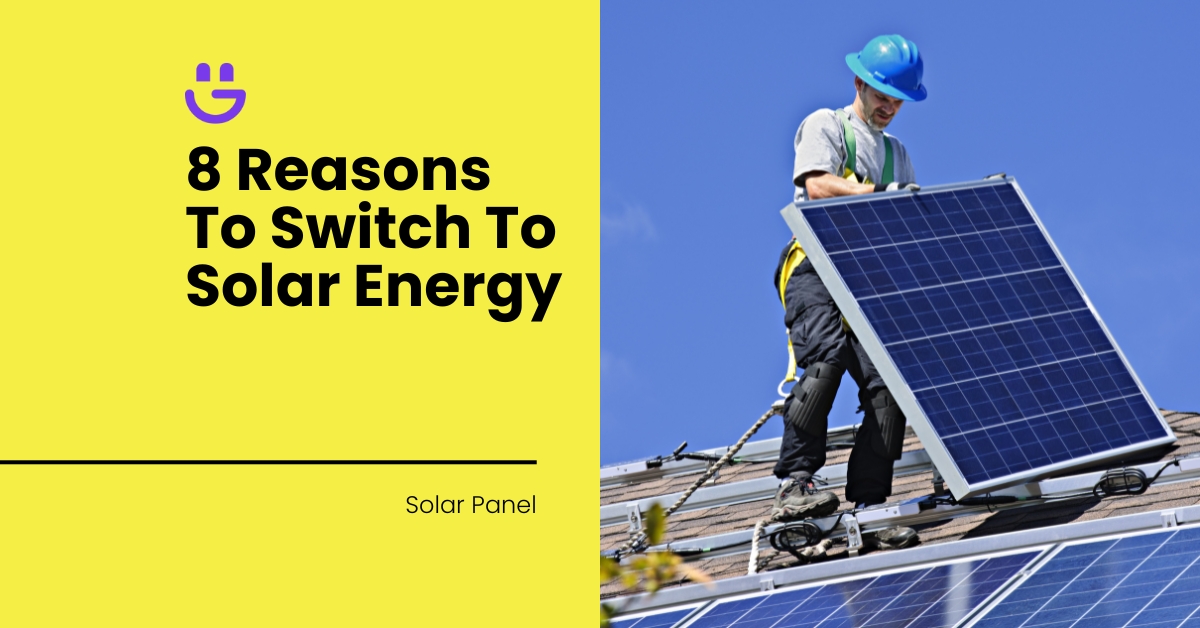Last Updated on November 14, 2025
With dozens of different types of solar panels out there, it can be challenging to choose the right solar panel system for your needs. The first modern solar panels were developed in 1954, and since then, many variations have surfaced.
In this article, we’ll provide an informative introduction to the many different types of solar panels!
Contents
What Are the Different Types of Solar Panels?
| Type of Solar Cell | Efficiency Rate | Pros | Cons | Applications |
|---|---|---|---|---|
| Monocrystalline Solar Panels | ~20% | High efficiency, long lifespan, compact. | Costly | Commercial and residential properties |
| Polycrystalline Solar Panels | ~15% | More affordable | Sensitive to high temperatures, shorter lifespan | Commercial and residential properties |
| Thin Film Solar Panels | ~7-10% | Easy to manufacture, affordable | Not very durable, takes up significant space | Commercial |
| Amorphous Silicon Solar Cells | ~7-10% | Can handle higher temperatures, flexible | Inefficient | Pocket calculators, small devices |
| Concentrated PV Cells | ~30-40% | Very efficient | Need to be placed at the perfect angle | Parking meters, traffic signs, etc. |
| Cadmium Telluride Solar Cells | ~10- 20% | Affordable to manufacture | Low efficiency, telluride is a rare material | Residential and commercial |
| Biohybrid Solar Panels | Almost 100% | High efficiency, compact design | Short lifespan | Not yet commercially available |
| Perovskite Solar Panels | ~25% | Efficient, low production cost | Vulnerable to moisture and high temperatures | Not yet commercially available |
| Zombie Solar Cells | ~25% | Compact, work indoors | Impractical | Still in the prototype stage |
| Quantum Dot Solar Cells | ~60% | High efficiency | Highly toxic in nature | Still in the prototype stage |
How Are Solar Panels Classified?
In most cases, solar panels are classified by their generations, which refers to the materials they’re made, their efficiency, and when they were invented. There are three main generations, including first-generation, second-generation, and third-generation solar panels. We’ll also look at the solar panels of the next generation.
First-generation solar panels
First-generation solar panels are the traditional and most popular choice for commercial and domestic solar panels. They are made from monocrystalline silicon or polysilicon and can be seen on rooftops all over the UK and beyond.
Monocrystalline solar panels
- Average efficiency rating: ~20%
Monocrystalline solar panels are highly regarded for their efficiency, often reaching around 20%. These panels are optimised for both commercial and residential use due to their high power output, long life expectancy, and compact design. Notably, monocrystalline panels are typically dark in color, often appearing black, and feature rounded edges, giving them a sleek and uniform appearance.
This aesthetic quality, along with their high efficiency, makes black solar panels a popular choice for many homeowners. If you’re considering black panels and wondering if they are worth the investment, it’s important to understand both their performance and visual appeal.
Polycrystalline solar panels
- Average efficiency rating: ~15%
Polycrystalline panels are quickly distinguishable thanks to their blue, speckled appearance. This type is created by melting raw silicon, which makes polycrystalline solar panels more affordable than monocrystalline solar panels. However, polycrystalline panels are not as compact and have a shorter lifespan.
Second-generation solar panels
Second-generation solar panels are mostly used for photovoltaic power stations and smaller solar systems. There are two main types of cells, including thin film solar cells and amorphous silicon solar cells.
Thin film solar panels
- Average efficiency rating: ~7-10%
While they may not be the most efficient option, thin film solar panels are praised for being an affordable alternative that is easy to manufacture. They are produced by placing films of photovoltaic material onto a substrate and are not affected by high temperatures. The only drawback is that they take up a lot of space, which makes thin-film solar cells unsuitable for residential homes.
Amorphous silicon solar cells
- Average efficiency rating: ~7-10%
Amorphous silicon solar cells have been used to power solar pocket calculators for years. The triple-layered technology is relatively easy to manufacture, which results in affordable pricing. While their efficiency may not be nearly as high as other types of solar panels, there are plenty of potential applications for the amorphous silicon solar cell.
Third-generation solar panels
Most third-generation solar panels are still in the research stage and are not yet commercially available. Many of these solar panels use thin-film technology and are looked to as the future of solar power and sustainable energy solutions.
Concentrated PV cells
- Average efficiency rating: ~30-40%
Concentrated PV cells combine direct and indirect solar power systems and are praised for being one of the most efficient options available. However, these panels need to be at the perfect angle to reach maximum efficiency. In most cases, a tracker is placed inside each cell so that they can follow the sun throughout the day.
Cadmium telluride solar cells
- Average efficiency rating: ~10- 20%
Like most solar panels that make use of thin-film technology, cadmium telluride solar cells are much more affordable than more traditional options. While cadmium is a relatively abundant resource, telluride is a rare resource. Many people are also put off by the toxicity levels in cadmium.
Biohybrid solar panels
- Average efficiency rating: Almost 100%
A biohybrid solar cell works by emulating the process of photosynthesis by combining inorganic and organic matter. While this type of solar technology is still in the research phase, it has shown immense potential. In comparison to traditional solar panels, biohybrid solar cells are thinner, more eco-friendly, more affordable, and take up less space.
Perovskite solar panels
- Average efficiency rating: ~25%
While perovskite solar panels are not yet commercially available or viable, prototypes have been used to power wireless electronic devices. The main issue that these solar cells face is their fast degradation. If this problem is resolved, perovskite solar panel technology can reach its full potential.
Next-generation solar panels
Next-generation solar panels are still in the developmental stages but many of them could be made commercially available within the next few years.
Zombie solar cells
- Average efficiency rating: ~25%
Roughly the size of a credit card, zombie solar cells can adapt to the amount of available light and will even be able to work indoors! They get their unusual name based on the discovery that some solar technologies actually work better once their liquid electrolyte dries out.
Quantum dot solar cells
- Average efficiency rating: ~60%
This technology makes use of tiny spheres of semiconductor material, which help get more energy from each photon. This process can help maximise conversion efficiency and transform the entire industry in years to come.
What is the Best Type of Solar Panel for My Property?
While we have mentioned quite a few different types of solar panels, not all of them are commercially available. In most cases, the best solution would be to go for monocrystalline panels as they have been around for a while, are highly efficient, and have a long life expectancy.
However, there are instances in which polycrystalline panels or other types of solar technology may be better suited to your needs. There are a few factors that you should take into consideration when choosing solar panels, including:
- Your budget.
- The type of property you own.
- The amount of roof space you have available (some types require more space than others).
- How much electricity you use each month.
- The size of your property (including how many bedrooms).
- Where your property is located.
- The types of appliances you have in your home.
If you’re still not sure about what type of solar panel system is best suited to your home, get in touch with our expert solar panel installers who can help you make the right choice. Additionally, read our guide on questions to ask solar panel installers.
FAQs
Can I install solar panels on my own?
While it is legal to install your own solar panels in the UK, installing solar panels is a complicated process. There are many opportunities for things to go awry and you could end up injuring yourself or damaging the panels. This is a job that is best left to the professionals.
Are there certain types of solar panels that are better suited to commercial needs?
Monocrystalline solar panels are best suited for commercial use as they offer high efficiency and space-saving benefits. Polycrystalline solar panels are also a good choice for commercial applications. Solar tiles are also proving to be a popular option for UK businesses.
How much do solar panels cost?
3.5 to 4 kW solar panel systems can cost anywhere between £5,000 and £13,000, depending on your specific needs and the type of solar panels you choose to install. This may sound like a lot but remember that you’ll save hundreds of pounds when it comes to your electricity bill. You also have the opportunity to sell any excess energy to the national grid through the SEG scheme.
Conclusion
Yes, there are dozens of different types of solar panels out there and the choice can be confusing. But through proper research and seeking advice from professional solar panel installers, you can choose the type that is perfect for your property!
Reduce your carbon footprint and enjoy electricity bill savings from the moment you have your new solar panels installed. If you have any questions about the process or would like a quote, don’t hesitate to contact the expert team at Eco Happy today.





Tom Allen
Solar Expert